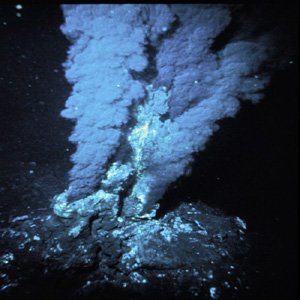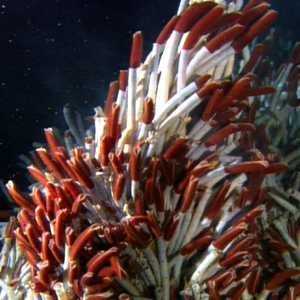Where life, not dependent on sunshine, also exists.
Hydrothermal vents.
These features of the deep sea have bought about an understanding about whole new ecosystems since their discovery.
These power ecosystems based on chemosynthesis.
The early colonisers of these environments are tube worms.
Scientists were totally blown away when these were first discovered, firstly there was no light, secondly pressurs at this depth of the ocean are often extreme and temperatures around thes vent are often close to boiling point.
Yet here we have total ecosystems living and thriving. This has produced a whole new possibility for finding life on other planets.
Our solar system alone has a number of planets and moons that are covered in thick ice but are considered to have oceans of liquid water underneath that ice, that is kept liquid due to heat from volcanic activity within the planet or moon.
Some scientists are wondering if the first life on earth did not emerge around these types of vents in the form of extremophiles.
You can find out more about chemosynthesis and extremophiles here.


Don't make me remember smoke I have to search my lighter
Hi @gavvet Interesting your post.
As you know, photosynthesis is the process by which plants use the sun’s energy to make sugar (glucose) for food. Plants absorb energy from sunlight, take in carbon dioxide from the air through their leaves, take up water through their roots, and produce glucose and oxygen. Photosynthesis takes place on land and in shallow water where sunlight can reach seaweeds.
Chemosynthesis is the process by which food (glucose) is made by bacteria using chemicals as the energy source, rather than sunlight. Chemosynthesis occurs around hydrothermal vents and methane seeps in the deep sea where sunlight is absent. During chemosynthesis, bacteria living on the sea floor or within animals use energy stored in the chemical bonds of hydrogen sulfide and methane to make glucose from water and carbon dioxide (dissolved in sea water). Pure sulfur and sulfur compounds are produced as by-products.
Have a wonderful Sunday
A hug
Nice post u.
I really love to see discoveries,
And histories of plant anthropology.
Please help my growth on steemit
I have ideas only steem can make them work.
Thanks in anticipation Good one from @gavvet
nice
We have not discovered many things yet and don't know how the many animals and like these tube worms continue their lives with zero light. The ecosystem is so wired and beautiful to me.
Excellent post.It's great to learn about hydro thermal vents and bizarre giant tube worms. It is an undiscovered ecosystem that I never knew existed, this world is truly spectacular with lots of interesting stuff. I can just imagine a 6 foot worm and how come we were never taught chemosynthesis in school? Until now I only knew about photosynthesis....Thank you for sharing
This is really a great discovery... Maybe other life's exist... God is great.. Thanks for this information
I love reading about stuff like this, thanks for sharing! :)
Great post. I love how fascinating and beautiful life on this planet is.
Symbiotic bacteria that feed on the sulfur which in turn feeds the worms. Wow, that's amazing.
I always thought that cells usually feed on sunlight (photosynthesis by chloroplasts) or glucose (animal cells by mitochondria) but it turns out that bacteria can also feed on sulfur.
Great post =)
Life always seem to find a way, no matter the conditions.
The oceans, especially the bottom of the oceans hold so many secrets that are yet to be discovered. I may even go as far and say that with the current level of technology, researching the oceans will lead to more interesting finds than going to space.
Your post was mentioned in the Steemit Hit Parade in the following category:Congratulations @gavvet!
when I first saw this on Planet Earth 2 (?), I was mesmerised. Nothing seemed as alien to me as this.